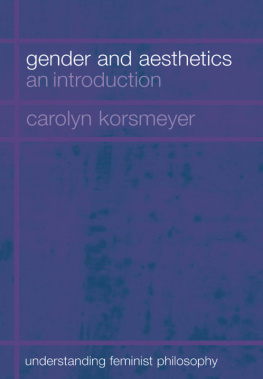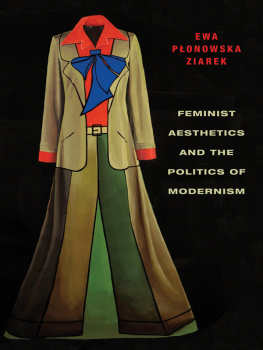Korsmeyer - Gender and Aesthetics: An Introduction; Gender and Aesthetics
Here you can read online Korsmeyer - Gender and Aesthetics: An Introduction; Gender and Aesthetics full text of the book (entire story) in english for free. Download pdf and epub, get meaning, cover and reviews about this ebook. City: New York;Florence, year: 2004, publisher: Routledge, Taylor & Francis Group [distributor, genre: Romance novel. Description of the work, (preface) as well as reviews are available. Best literature library LitArk.com created for fans of good reading and offers a wide selection of genres:
Romance novel
Science fiction
Adventure
Detective
Science
History
Home and family
Prose
Art
Politics
Computer
Non-fiction
Religion
Business
Children
Humor
Choose a favorite category and find really read worthwhile books. Enjoy immersion in the world of imagination, feel the emotions of the characters or learn something new for yourself, make an fascinating discovery.
- Book:Gender and Aesthetics: An Introduction; Gender and Aesthetics
- Author:
- Publisher:Routledge, Taylor & Francis Group [distributor
- Genre:
- Year:2004
- City:New York;Florence
- Rating:4 / 5
- Favourites:Add to favourites
- Your mark:
- 80
- 1
- 2
- 3
- 4
- 5
Gender and Aesthetics: An Introduction; Gender and Aesthetics: summary, description and annotation
We offer to read an annotation, description, summary or preface (depends on what the author of the book "Gender and Aesthetics: An Introduction; Gender and Aesthetics" wrote himself). If you haven't found the necessary information about the book — write in the comments, we will try to find it.
Korsmeyer: author's other books
Who wrote Gender and Aesthetics: An Introduction; Gender and Aesthetics? Find out the surname, the name of the author of the book and a list of all author's works by series.
Gender and Aesthetics: An Introduction; Gender and Aesthetics — read online for free the complete book (whole text) full work
Below is the text of the book, divided by pages. System saving the place of the last page read, allows you to conveniently read the book "Gender and Aesthetics: An Introduction; Gender and Aesthetics" online for free, without having to search again every time where you left off. Put a bookmark, and you can go to the page where you finished reading at any time.
Font size:
Interval:
Bookmark:
Feminist approaches to art are extremely influential and widely studied across a variety of disciplines, including art theory, cultural and visual studies, and philosophy. Gender and Aesthetics carefully introduces and examines the role that gender plays in forming philosophical ideas about art.
The book discusses important topics within feminist aesthetics:
Why were there so few women artists in the past?
Art, pleasure, and beauty
The role of gender in taste and food
What is art and what makes an artist?
Disgust, sublimity, and aesthetic values
The body and the formation of subjectivity
The book introduces in clear language the role gender plays in our understanding of art, creativity, and aesthetic qualities. Philosophies of the past are examined for their influence over gendered ways of conceiving aesthetics; and contemporary theorists such as Arthur Danto and Luce Irigaray are situated in relation to feminist art practices. Each chapter concludes with a summary, and there is an extensive bibliography.
Carolyn Korsmeyers style is refreshing and accessible, making the book suitable for students of philosophy, gender studies, visual studies, and art theory, as well as anyone interested in the impact of gender on aesthetics.
Carolyn Korsmeyer is Professor of Philosophy at the University at Buffalo, State University of New York. She is author of Making Sense of Taste: Food and Philosophy (1999) and the editor of several books on aesthetics, feminism, and literary theory.
Edited by Linda Martin Alcoff
This major new series is designed for students who have typically completed an introductory course in philosophy and are coming to feminist philosophy for the first time. Each book clearly introduces a core undergraduate subject in philosophy, from a feminist perspective, examining the role gender plays in shaping our understanding of philosophy and related disciplines. Each book offers students an accessible transition to higher-level work on that subject and is clearly written, by an experienced author and teacher, with the beginning student in mind.
GENDER AND AESTHETICS
Carolyn Korsmeyer
FEMINISM AND MODERN PHILOSOPHY
Andrea Nye
FEMINISM AND EPISTEMOLOGY
Phyllis Rooney
FEMINISM AND PHILOSOPHY OF SCIENCE
Elizabeth Potter
Carolyn Korsmeyer

First published 2004
by Routledge
29 West 35th Street, New York, NY 10001
simultaneously published in the UK
by Routledge
11 New Fetter Lane, London EC4P 4EE
Routledge is an imprint of the Taylor & Francis Group
2004 Carolyn Korsmeyer
Typeset in Joanna by The Running Head Limited, Cambridge
Printed and bound in Great Britain by
TJ International Ltd, Padstow, Cornwall
All rights reserved. No part of this book may be reprinted or reproduced or utilized in any form or by an electronic, mechanical, or other means, now known or hereafter invented, including photocopying and recording, or in any information storage or retrieval system, without permission in writing from the publishers.
Library of Congress Cataloging in Publication Data
Korsmeyer, Carolyn.
Gender and Aesthetics : an introduction / Carolyn Korsmeyer.
p. cm (Understanding feminist philosophy)
Includes bibliographical references and index.
1. Feminism and art. 2. Women in art. 3. Feminist theory. 4. ArtsPhilosophy.
I. Title. II. Series.
N72.F45K67 2004
700.103082dc22
2003058656
British Library Cataloguing in Publication Data
A catalogue record for this book is available from the British Library
ISBN 0415266580 (hbk)
ISBN 0415266599 (pbk)
This book is dedicated to three girls who grew up together.
One became a dancer, one a writer, and one sang.
For the singer in memoriam
Auguste Rodin, The Eternal Idol, c. 1905.
Illuminated letter Q, signed Claricia. German psalter from Augsberg, late twelfth century.
Judith Leyster, Serenade, 1629.
William Hogarth, The Line of Grace. Detail after Plate I, The Analysis of Beauty, 1753.
Jean-Lon Grme, A Roman Slave Market, c. 1884.
Artemisia Gentileschi, Susanna and the Elders, 1610.
Johann Zoffany, The Academicians of the Royal Academy, 17712.
Paul Gauguin, Two Tahitian Women.
Jana Sterbak, Vanitas: Flesh Dress for an Albino Anorectic, 1987.
Nancy Spero, Egyptian figure/Acrobat/Dancing, 1988.
Ana Mendieta, Silueta Works in Iowa, 19761978/1991.
Cindy Sherman, Untitled #224, 1990.
I am fortunate to belong to a dedicated writing group whose members patiently read and commented on earlier drafts of this book. I would like to thank Carrie Tirado Breman, Ann Colley, and Rosemary Feal. Larry Shiner, whose own scholarship has taught me a great deal, generously read the book in draft and offered his thoughtful advice. Andrew Schwartz commented on ; Beth Ann Dobie contributed helpful information about the use of food in art; and Peg Brand offered suggestions about the project as it developed. Cynthia Freeland and Rachel Jones, in the guise of anonymous readers for the press, offered attentive and detailed comments that greatly aided the process of revision. I am grateful to all of them for their help.
The Office of the Dean of the College of Arts and Sciences at the University at Buffalo, State University of New York, generously supported the reproduction permissions for the illustrations. Siobhan Pattinson, editor at Routledge, was a great help obtaining permissions and seeing the book through to publication. Finally, I would like to thank Linda Alcoff for putting together the series, Understanding Feminist Philosophy, to which this book belongs.
T his book examines the theories and conceptual frameworks that operate in and around art and aesthetics. It addresses these subjects from a feminist perspective, that is, with attention to the roles that gender plays in the formation and application of ideas about artworks, creativity, and aesthetic value. This approach assumes that images, representations, and crafted expression of ideas are important not only for their beauty, virtuosity, or intrinsic value, but also because they are indicators of social position and power. Wherever there is power there are disparities in the ways that it is employed, and art is an enterprise where sex and sexuality, gender and social position, and cultural authority all have formidable roles. Aesthetic power is often hidden or overlooked; when one thinks of aesthetic value, the qualifier mere is often implicit, indicating the presumption that practical or moral values not only take precedence over aesthetic value but are cleanly separable from the way something looks, sounds, feels, or communicates emotions and ideas. Arts programs are among the first items to be cut from municipal budgets; they are often classified as contributors to the enrichment of public life that may be eliminated without major loss, comparable to skipping dessert with no sacrifice of nutrition. This is a grave error; art and aesthetic taste are powerful framers of self-image, social identity, and public values.
The philosophical discipline of aesthetics is by no means restricted to theories of art or of critical reception and enjoyment. Yet with the exception of artworks, few items of our world are assessed chiefly for their aesthetic qualities. For this reason, philosophy of art occupies center stage in aesthetic theory. Philosophy of art is intended to include all of the various arts, although the term art is elastic. It has a narrow use in English as well as some other languages insofar as it refers specifically to the graphic arts of painting, drawing, or printmaking, and when one first hears the word art a painting probably springs to mind. Much philosophical aesthetics already is predisposed to consider art in terms of the model of painting because of the influence of epistemology, which standardly employs visual examples in the analysis of perception and knowledge. Moreover, there has been an immense amount of feminist research on women in painting and in film. Such factors have tended to produce a skew towards the visual arts in aesthetic theory that this study shall attempt to avoid, though will not escape completely because of the stress on vision that the investigation of perception typically displays. Art also designates collectively all of the practices that cluster under the idea of fine art: music, theater, dance, poetry, prose literature, sculpture, architecture, and so on. What is more, sometimes art is employed expansively, such that popular movies and television series are included, but other times these media are designated (mere) entertainment rather than real art. Similarly, domestic crafts and artifacts made in non-western societies are sometimes classified as art but are often separately labeled crafts. The theoretical commitments that underlie distinctions drawn between art and entertainment, and between art and craft, are also subjects of this investigation. All of the various forms of art are important for the issues of this book, though not all are treated with equal weight. I have focused on several art formschiefly painting, music, literature, performanceto serve as the models for how gender analysis might proceed in the labyrinthine realms of aesthetics.
Font size:
Interval:
Bookmark:
Similar books «Gender and Aesthetics: An Introduction; Gender and Aesthetics»
Look at similar books to Gender and Aesthetics: An Introduction; Gender and Aesthetics. We have selected literature similar in name and meaning in the hope of providing readers with more options to find new, interesting, not yet read works.
Discussion, reviews of the book Gender and Aesthetics: An Introduction; Gender and Aesthetics and just readers' own opinions. Leave your comments, write what you think about the work, its meaning or the main characters. Specify what exactly you liked and what you didn't like, and why you think so.













